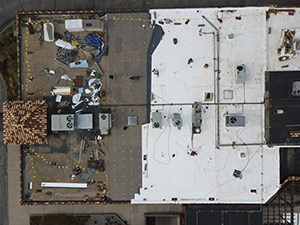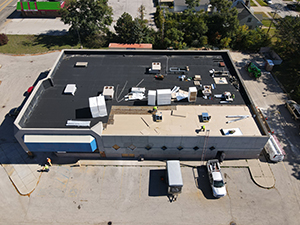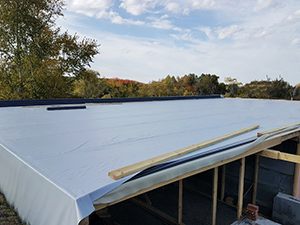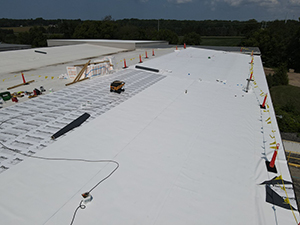Standing water is one of the most common causes of premature roof failure. On commercial and residential roofs alike, areas around chimneys, drains, or transitions can easily develop ponding water if there’s no way for runoff to escape. That’s where roof crickets come in. A cricket is a raised, sloped structure designed to divert water toward drains or gutters. Depending on the roof type, budget, and drainage needs, there are several ways to construct crickets. Below, we explore the most common methods and their advantages.
Shark Commercial Roofing Systems specializes in hospital and medical facility roofing systems throughout the Los Angeles, CA region. Call 213-466-0074 today to schedule your consultation.
Hospital Roofing Drainage Crickets
Built-In Structural Crickets
Built-in crickets are framed into the roof deck using wood or light-gauge steel. They are part of the permanent structure and then covered with the chosen roofing system.
Why they work:
- Provide the most durable and long-lasting slope correction.
- Custom-built to fit roof geometry precisely.
- Suitable for all roof systems (single-ply, BUR, shingles, or tile).
Best for: New construction or major roof replacement projects where long-term performance is the priority.
Tapered Insulation Crickets
Instead of framing, many contractors create slope with tapered insulation boards, usually polyiso. These boards are cut and layered to form the cricket, then covered with membrane or coating.
Why they work:
- Lightweight and easy to install.
- Less expensive than structural framing.
- Effective solution for retrofits and restorations.
Best for: Flat commercial roofs that need drainage improvement without structural changes.
Sheet-Metal Crickets
Fabricated from galvanized steel, aluminum, or copper, sheet-metal crickets are typically used in smaller, concentrated drainage areas like behind chimneys or in roof valleys.
Why they work:
- Durable and resistant to water damage.
- Provide smooth, fast runoff.
- Customizable in the shop or on site.
Best for: Steep-slope systems with shingles, slate, or tile, where precise water diversion is critical.
BUR/Modified Bitumen Crickets
For built-up roofing (BUR) or modified bitumen systems, crickets are often made by layering roofing plies and asphalt over a shaped base of wood or insulation.
Why they work:
- Seamlessly integrates with multi-ply roof systems.
- Creates a heavy-duty solution for flat roofs.
- Provides decades of performance when installed properly.
Best for: Older buildings or facilities with BUR roofs needing reliable long-term drainage solutions.
Coating-Integrated Crickets
In restoration projects, crickets can be formed using foam or lightweight concrete and then sealed with fluid-applied coatings (silicone, acrylic, or urethane).
Why they work:
- Quick installation without heavy construction.
- Creates a seamless, waterproof surface.
- Can extend roof life while solving ponding issues.
Best for: Budget-conscious building owners who need functional drainage improvements during a roof coating project.
Quick Comparison Table
| Type | Cost | Lifespan | Speed | Best Use Case |
| Built-In Structural | $$$$ | 30–50+ years | Slow | New builds, major rebuilds |
| Tapered Insulation | $$ | 20–30 years | Fast | Retrofits, low-weight solution |
| Sheet-Metal | $$-$$$ | 40+ years | Medium | Chimneys, steep slope |
| BUR/Mod Bit | $$$ | 25–40 years | Medium | Heavy-duty flat roof |
| Coating-Integrated | $-$$ | 10–20 years | Fast | Low-budget, quick fix |
Choosing the Right Cricket for Your Hospital Roof
The right cricket construction depends on your roof type, the severity of drainage issues, and budget. For new builds or complete replacements, structural crickets deliver the longest service life. If you’re restoring a commercial flat roof, tapered insulation or coating-integrated options may provide the most cost-effective improvement. Steep-slope homes with chimneys almost always benefit from sheet-metal crickets.
No matter which type you choose, properly designed crickets dramatically reduce the risks of ponding water, leaks, and premature membrane failure, helping you maximize roof performance and protect your investment.
Hospital Roofing Experts
Whether you oversee a huge metropolitan hospital or a small, private clinic, adequate drainage is key to the longevity and performance of your roofing system. Call on Shark Commercial Roofing today at 213-466-0074 to learn more about addressing your drainage issues.











